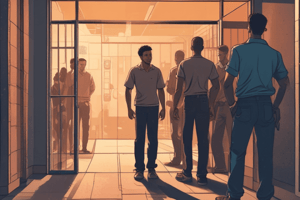Podcast
Questions and Answers
What are the factors that influence the decision of law enforcement in dealing with youthful offenders?
What are the factors that influence the decision of law enforcement in dealing with youthful offenders?
- The offender's age, gender, and race
- The officer's workload, personal beliefs, and mood
- The offender's profile, officer's perspective, and available community alternatives (correct)
- The offender's family background, income, and education level
What is delinquency adjudication?
What is delinquency adjudication?
- A process where youthful offenders are sentenced to life imprisonment
- A process where youthful offenders are assigned community service
- A process where youthful offenders are assigned probation officers and ongoing supervision (correct)
- A process where youthful offenders are given a warning and released
How can incarceration facilities decrease recidivism among youthful offenders?
How can incarceration facilities decrease recidivism among youthful offenders?
- By providing them with better food and living conditions
- By punishing them severely for any wrongdoing
- By providing them with treatment services and quality education programs (correct)
- By isolating them from other inmates
What is the harmful impact of incarceration on adolescents' development and functioning?
What is the harmful impact of incarceration on adolescents' development and functioning?
Who are more likely to be involved with adult criminal courts?
Who are more likely to be involved with adult criminal courts?
What is the impact of solitary confinement on youthful offenders?
What is the impact of solitary confinement on youthful offenders?
What is the risk of suicide in detention and incarceration facilities?
What is the risk of suicide in detention and incarceration facilities?
What is the potential violation of youthful offenders' rights in transfers to criminal court?
What is the potential violation of youthful offenders' rights in transfers to criminal court?
What is the recidivism rate of adult imprisonment?
What is the recidivism rate of adult imprisonment?
What are the barriers to successful reentry into communities for adult prisoners?
What are the barriers to successful reentry into communities for adult prisoners?
Study Notes
- Law enforcement has various options for dealing with youthful offenders.
- Factors that influence the decision include profile, officer's perspective, and available community alternatives.
- Delinquency adjudication assigns probation officers and ongoing supervision to the juvenile.
- Incarceration facilities that provide treatment services and quality education programs can decrease recidivism.
- Incarceration has a harmful impact on adolescents' development and functioning.
- Youthful offenders who start offending behavior early and continue through later teen years are more likely to be involved with adult criminal courts.
- Solitary confinement has a debilitating and permanent harmful impact on youthful offenders.
- Suicide risk increases in detention and incarceration facilities.
- Transfers to criminal court may violate youthful offenders' rights to due process.
- Adult imprisonment has high recidivism rates and poses significant barriers to successful reentry into communities.
Studying That Suits You
Use AI to generate personalized quizzes and flashcards to suit your learning preferences.
Description
Explore the various options law enforcement has for handling youthful offenders, factors influencing decisions, and the impact of adjudication, incarceration, and transfers to criminal court. Learn about the harmful effects of incarceration, solitary confinement, and adult imprisonment on adolescent development and functioning.



